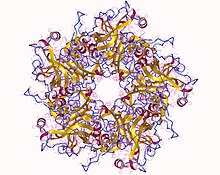| Human papillomavirus infection | |
|---|---|
| Other names | Human papillomavirus |
 | |
| The major capsid protein L1 of HPV 11 | |
| Specialty | Infectious disease, gynecology, oncology |
| Symptoms | None, warts[1][2] |
| Complications | Cancer of the cervix, vulva, vagina, penis, anus, mouth or throat[1][2] |
| Causes | Human papillomavirus spread by direct contact[3][4] |
| Prevention | HPV vaccines, condoms[3][5] |
| Frequency | Most people are infected at some point in time[3] |
Human papillomavirus infection (HPV infection) is an infection caused by the human papillomavirus (HPV).[4] About 90% of HPV infections cause no symptoms and resolve spontaneously within two years.[1] However, in some cases, an HPV infection persists and results in either warts or precancerous lesions.[2] These lesions, depending on the site affected, increase the risk of cancer of the cervix, vulva, vagina, penis, anus, mouth, or throat.[1][2] Nearly all cervical cancer is due to HPV; two types, HPV16 and HPV18, account for 70% of cases.[1][6] Between 60% and 90% of the other cancers listed above are also linked to HPV.[6] HPV6 and HPV11 are common causes of genital warts and laryngeal papillomatosis.[1]
An HPV infection is caused by human papillomavirus, a DNA virus from the papillomavirus family.[7] Over 170 types have been described.[7] More than 40 types may be spread through sexual contact and infect the anus and genitals.[3] Risk factors for persistent infection by sexually transmitted types include early age of first sexual intercourse, multiple sexual partners, smoking, and poor immune function.[1] These types are typically spread by sustained direct skin-to-skin contact, with vaginal and anal sex being the most common methods.[3] Also, HPV infection can spread from a mother to baby during pregnancy.[8] There is no evidence that HPV can spread via common items like toilet seats,[9] but the types that cause warts may spread via surfaces such as floors.[10] An individual can become infected with more than one type of HPV.[8] HPV is only known to affect humans.[4][11]
HPV vaccines can prevent the most common types of infection.[3] To be most effective, vaccination should be used before the onset of sexual activity, and are therefore recommended between the ages of 9–13 years.[1] Cervical cancer screening, such as the Papanicolaou test ("pap smear"), or examination of the cervix after applying acetic acid, can detect both early cancer and abnormal cells that may develop into cancer.[1] Screening allows for early treatment which results in better outcomes.[1] Screening has reduced both the number of cases and the number of deaths from cervical cancer.[12] Genital warts can be removed by freezing.[4]
Nearly all people are infected by HPV, at some point in their lives.[3] HPV is the most common sexually transmitted infection (STI), globally.[4] Worldwide in 2018, an estimated 569,000 new cases of cervical cancer occurred, with 311,000 deaths.[13] Around 85% of these cervical cancers occurred in low- and middle-income countries.[1] In the United States, about 30,700 cases of cancer due to HPV occur each year.[14] Roughly, 1% of sexually active adults, have genital warts.[8] Cases of skin warts have been described since the time of ancient Greece, while the fact that they are caused by a virus was determined in 1907.[15]
References edit
- ^ a b c d e f g h i j k "Human papillomavirus (HPV) and cervical cancer". WHO. June 2016. Archived from the original on 5 August 2016.
- ^ a b c d Ljubojevic S, Skerlev M (2014). "HPV-associated diseases". Clinics in Dermatology. 32 (2): 227–34. doi:10.1016/j.clindermatol.2013.08.007. PMID 24559558.
- ^ a b c d e f g "What is HPV?". CDC. 28 December 2015. Archived from the original on 7 August 2016. Retrieved 10 August 2016.
- ^ a b c d e Milner, Danny A. (2015). Diagnostic Pathology: Infectious Diseases. Elsevier Health Sciences. p. 40. ISBN 9780323400374. Archived from the original on 11 September 2017.
- ^ "Fact Sheet for Public Health Personnel | Condom Effectiveness | CDC". www.cdc.gov. 25 March 2013. Archived from the original on 27 May 2017. Retrieved 1 May 2017.
- ^ a b "The Link Between HPV and Cancer". CDC. September 30, 2015. Archived from the original on 9 November 2015. Retrieved 11 August 2016.
- ^ a b Bzhalava D, Guan P, Franceschi S, Dillner J, Clifford G (October 2013). "A systematic review of the prevalence of mucosal and cutaneous human papillomavirus types". Virology. 445 (1–2): 224–31. doi:10.1016/j.virol.2013.07.015. PMID 23928291.
- ^ a b c "Human Papillomavirus (HPV) Questions and Answers". CDC. 28 December 2015. Archived from the original on 11 August 2016. Retrieved 11 August 2016.
- ^ "5 Things You Might Not Know About Human Papillomavirus". CDC. Archived from the original on 22 June 2020. Retrieved 22 May 2020.
- ^ "Human Papilloma Virus (HPV)" (PDF). WRHA. 18 November 2019. Archived (PDF) from the original on 26 March 2019. Retrieved 26 March 2019.
- ^ "Pink Book (Human Papillomavirus)" (PDF). CDC.gov. Archived (PDF) from the original on 21 March 2017. Retrieved 18 April 2017.
- ^ Sawaya GF, Kulasingam S, Denberg TD, Qaseem A (June 2015). "Cervical Cancer Screening in Average-Risk Women: Best Practice Advice From the Clinical Guidelines Committee of the American College of Physicians". Annals of Internal Medicine. 162 (12): 851–9. doi:10.7326/M14-2426. PMID 25928075.
- ^ "Global Cancer Observatory: International Agency for Research on Cancer" (PDF). IARC. Archived from the original (PDF) on 11 October 2018. Retrieved 16 March 2019.
- ^ Viens LJ, Henley SJ, Watson M, Markowitz LE, Thomas CC, Thompson TD, et al. (July 2016). "Human Papillomavirus-Associated Cancers - United States, 2008-2012". MMWR. Morbidity and Mortality Weekly Report. 65 (26): 661–6. doi:10.15585/mmwr.mm6526a1. PMID 27387669.
- ^ Tyring, Stephen; Moore, Angela Yen; Lupi, Omar (2016). Mucocutaneous Manifestations of Viral Diseases: An Illustrated Guide to Diagnosis and Management (2nd ed.). CRC Press. p. 207. ISBN 9781420073133. Archived from the original on 3 August 2020. Retrieved 3 August 2020.